Abstract
This research aimed to provide the Welsh Government with measured and quantified climate vulnerabilities associated with housing building-fabric, including the potential financial cost of not planning for climate change. Wales’s climate is projected to become warmer but wetter and it is known that hygrothermal impacts can accelerate deterioration, leading to damp and, subsequently, a loss of thermal performance. A stressor-response methodology was applied, which assumes that the exogenous stressors of solar flux, precipitation, and humidity have a direct effect on building-fabric performance. The resultant stressor-response values equate to the quantitative impact that a specific stressor has on individual specific building elements, presented as an adjusted service life and associated costs. Results show a modest reduction in the service life of building materials due to increases in and changing patterns of precipitation and subsequent moisture ingress. Although modest, with 1.5 million dwellings in Wales, the impact is significant. Advocating regular maintenance and repair will not only reduce the risks associated with changing weather patterns, but also encourage energy efficiency by improving the thermal performance of the building envelope. This will reduce the risk of adverse climate related outcomes, increased vulnerability to climate change, now or in the future.
1. Introduction
Buildings exposed to weather and climate-related natural hazards attract much attention because of the immediacy of the losses. Nevertheless, cumulative degradation risks are also perceived to be increasing due to climate change. Although previous studies have discussed the implications of climate change impacts on older buildings in Europe [1], and the expected changes in the climate that are of importance to buildings in the UK [2], there is a paucity of studies that aim to measure or model the future impact of climate change on buildings, no studies have specifically looked at Wales and its buildings, and no studies have strived to measure of the impact of climate change on dwellings in Wales. This research project was commissioned by the Welsh Government, who have devolved competencies in policy areas relating to building standards, and aimed to identify quantifiable and measurable climate vulnerabilities for Wales’s housing stock, and this paper focuses on building-fabric vulnerabilities.
Under the Climate Change Act 2008, the UK Government is required to address the challenges of climate change, including threats to infrastructure as well as health, economy and the natural environment. One important aspect of this is the climate vulnerabilities associated with buildings, including schools, hospitals, municipal buildings, public and private housing. In 2019, the Committee for Climate Change suggested that the UK’s aging housing stock is “not fit for the future” [3] (p. 9), and Wales has the largest proportion of aged dwellings in the UK, with 26% over 100 years old. Indeed, in the Committee for Climate Change’s second Climate Change Risk Assessment (CCRA2) report of 2017 [4], they identified the existence of evidence gaps, the need to prioritise areas of research in order to fully understand the risks and the development of policy to manage the impacts of those risks, including risks to building-fabric from moisture, wind, and driving rain under future climate driven changes in weather patterns. In 2020, Natural Resources Wales (NRW) published their second “State of the Natural Resources” (SoNaR) report [5], where they set out flooding risks to buildings largely informed by the results of CCRA2. More recently, CCRA 3, published in 2021, identified further investigation is needed to understand risks to building-fabric. CCRA3 concludes that progress in adaptation policy and implementation is not keeping up with the rate of increase in climate risk [6].
Wales’s climate is predicted to be warmer and wetter [7]. Changes in climate factors are expected to accelerate the deterioration of building materials and their detailing, including undermining binders and coating of building façades [8,9]. Climate change will undoubtedly have some impact of building-fabric performance and any acceleration in the erosion of building materials will depend on their inherent characteristics, as well as the prevalent climate stressor. The cyclical expansion and contraction of masonry and mortars are subject to the weathering cycle, which may alter because of climate change. For example, solid masonry walls that are characterised by higher surface water absorption coefficients and are more sensitive to exterior climate factors, such as rain and wind; but they will also react to solar radiation, which can reduce moisture accumulation considerably [10,11].
Simulating the onsite conditions of masonry structures subjected to rising damp and salts attack, due to daily and seasonal microclimate changes, as foreseen due to changing weather patterns, has established that building-fabric will be weakened in the long run, e.g., Franzoni et al. [12]. Differential expansion and shrinkage in various materials forming the building envelope can also be induced by temperature oscillation and temperature gradients across buildings [13]. Previous research by Facconi et al. has determined that daily temperature variations of circa 14 °C, or more, could induce cracking [14]. These daily temperature gradients are particularly harmful as they can induce strain accumulations in materials, which can lead to microcracking, which, in turn, can change the permeability of the outer surface and make them more susceptible to the adverse effects of wind-driven rain, as well as other sources of moisture [15]. Consequently, weakening building materials and strain values beyond reversible limits can create damage via creep (slow downward progression) and fatigue in many construction materials, including natural stone, concrete, and brick [16,17,18].
Studies on climate change and the effect that increased extreme rainfall events may have on building façades has renewed the scientific interest on determining the risk of accelerated surface erosion [19]. Among all extreme climate factors, wind-driven rain (WDR) impacts are likely to be the most pervasive across Wales and the UK. WDR can cause both surface erosion and weaken building-fabric. Nik et al.’s [20] investigation on the prospective impacts of climate change and WDR on buildings found that higher amounts of moisture will accumulate in walls in the future. In addition to WDR, moisture that diffuses across the wall as vapor was proven to be another main source of moisture accumulation.
Moisture related risks to the building envelope are found in buildings with large rates of moisture production or lack of ventilation. Wetted or damp building materials are usually contaminated by fungi and especially by moulds. Consequently, mould growth is one of the most common ways that moisture-induced deterioration manifests itself on buildings and the risk of mould growth increases considerably when the relative humidity of a construction material exceeds 80%. Many researchers have studied the relationship between diffusion, the transport of moisture across the building envelope, and indoor temperature and humidity, with a particular focus on mould growth. Mould growth negatively affects the durability of the building envelope, as well as the environmental quality of the internal climate [21,22]. In addition to material type (and consequently material surface characteristics) the cleanliness of material surfaces are important considerations. Viitanen et al. [23] compared stone with timber and found that surface type and dirtiness of material has an influence on mould growth. In wood materials the finish of the surface was a critical factor, e.g., more mould growth was detected on planed pine sapwood than in edge-glued spruce board. Grant et al. [24] found that surfaces which are soiled or covered with a susceptible paint or paper do not need to become as damp for mould to develop. Climate change will inevitably impose new challenges for mould prevention, as well as other weather-accelerated building-fabric weakness.
2. Methodology
The main aim of this discrete piece of research was to identify quantifiable and measurable climate vulnerabilities for the building-fabric of Welsh dwellings, including an indication of the potential financial cost of not planning for climate change. A 2009 study by the World Bank on the economics of adaptation to climate change, published in 2010, estimated that urban housing costs could increase between USD 23.3 billion and USD 41.1 billion per year in the period 2010–2050 because of climate change impacts [25]. A failure to properly incorporate climate change factors into housing stock management decision-making could result in costly impacts, including roof and drainage issues, cladding and exterior façade deterioration, and issues with the foundation of buildings, among many others. It was intended that, evidence of vulnerability related to, the Welsh Government could create actionable strategies to prepare building owners and occupiers for projected climate change impacts on their dwellings and those that they manage.
The existing literature relating to climate change adaptation is primarily qualitative in nature, with an emphasis on specific case studies, broad recommendations, and hazard warnings. The stressor-response approach diverges from this literature base by considering the impact of incremental changes in weather patterns (e.g., wetter, warmer weather) in response to recommendations that indicate a broader, more holistic perspective would be beneficial and result in less vulnerability; therefore, reducing risks associated with climate change hazards, e.g., Berdica and Erath et al. [26,27]. Consequently, to determine the degree of climate change impacts on Welsh housing stock, a methodology, based on a stressor-response approach, was adopted after Chinowsky and Arndt [28].
2.1. Stressor-Response
The stressor-response approach utilises an assumption that exogenous factors or stressors have a direct effect on focal elements of a building, its materials and component parts. In this context, the exogenous factors considered were projected incremental changes to solar flux, precipitation, and humidity. The resultant stressor-response values were the quantitative impact that a specific stressor has on specific building elements, presented as an adjusted service life and associated costs. The procedure is detailed further in Section 2.4.
The systematic approach for determining the potential impacts of climate change on building-fabric involved three steps of analysis:
- Climate model projections;
- Existing building stock assessments; and
- Analysis of climate change impacts on building components.
2.2. Climate Model Projections
The UK Climate Projections 2018 (UKCP18) local (2.2 km) projections for 12 Met Office Hadley Centre models (HadGEM3-GC3.05) under Representative Concentration Pathway (RCP) 8.5 [29] were used to inform the climate vulnerability modelling.
The Met Office [30] acknowledge that it is not possible to give a precise prediction of how weather and climate will change years into the future, so UKCP18 provides ranges that aim to capture a spread of climate response based on current knowledge and using a particular set of methodologies developed by the Met Office and collaborators [30]. RCP 8.5 is the only representative concentration pathway available for the 2.2 km scale data [31]. A Representative Concentration Pathway (RCP) is a Greenhouse Gas concentration (not emissions) trajectory, adopted by the Intergovernmental Panel on Climate Change (IPCC). When compared to the total set of RCPs, 8.5 is the highest scenario in assumed fossil fuel use, and thus corresponds to the pathway with the most greenhouse gas emissions [32]. Not only are the emissions consistent with RCP8.5 in close agreement with historical total cumulative CO2 emissions (within 1%), but RCP8.5 is also the best match to mid-century, under current and stated policies; with still highly plausible levels of CO2 emissions in 2100 [33]. RCP 8.5 is widely endorsed by the UK Met Office and the Intergovernmental Panel on Climate Change (IPCC) as an appropriate tool for considering risk and identifying future vulnerabilities.
Collectively, climate observations and projections can be used as a resource as well as a communication tool when planning for the future [30]. Although the projections represent the latest scientific understanding, it is important to note uncertainties in the projections.
Therefore, although our ability to simulate the climate is advancing all the time, models are not able to represent every possible climate characteristic [30]. Variables used in this study included a daily relative humidity (average), daily precipitation (average), and daily solar flux (average). The 1981–2000 time period was used as the baseline, whilst the 2021–2040 and 2061–2080 time periods were used for 2030 and 2070, respectively. Values presented represent the average year across the respective 20-year time period and the median model across the 12 climate models. The analysis periods for the building-fabric vulnerability metrics each include data for 1 January–31 December inclusively.
2.3. Dwelling Appraisal
The potential impact of climate change on building-fabric can be varied and extensive. As outlined above, variations in, e.g., precipitation and temperature will have characteristic impacts. The approach described in this paper aimed to isolate: the distinctiveness of potential impacts to the principal components of the building envelope; ones that have been detailed in the aforementioned research; have technical responses that can be accomplished through focused repair, maintenance, and adaptation or refurbishment upgrades; and that are crucial to building design life performance. The stressor-response considered impacts on replacement, repair, and maintenance costs, i.e., increases or decreases in recurring maintenance cost that would be incurred due to anticipated climate change, in order to achieve the design lifespan or service life. In each of these, the underlying concept, is to retain or extend the life expectancy of a dwelling.
2.4. Climate Stressors
Exposure to damp as a result of relative humidity and precipitation are analysed. One of the primary accelerators of the degradation of external cladding materials is exposure to damp [34,35,36,37,38,39,40]. Solar exposure is another important factor in the durability of many organic materials used in dwelling construction. Photodegradation is initiated by UV photons in sunlight and generally involves chemical reactions with atmospheric oxygen and/or water vapor, leading to brittleness. Elevated temperatures, such as those caused by solar absorption in dark materials, also lead to acceleration of harmful chemical reactions [39].
Numerous studies [34,35,36,37,38,39,40] have utilised the ISO 15686 Factor Method procedure [41,42,43] to calculate adjusted service life factors based on exposure to various climate variables. Factors from these studies were assigned to each year in the projected climate models based on a binary high or low exposure criterion for each climate variable. High or low exposure was quantified as the change in the annual average value for the daily average humidity and solar flux, or the annual value in the case of precipitation, relative to the baseline for each building-fabric component. Factors representative of the mean year and median climate model were then applied to baseline service life values, as published in the British Standard 7543 [43], to find the adjusted service life under projected climate conditions. Three separate adjusted service lives were calculated, one for each climate variable, which were then used to calculate the percent change in maintenance and/or replacement costs for each building component. The building-fabric analysis is broken into three separate evaluations of vulnerability from solar exposure, from relative humidity, and from precipitation. Climate factors could not be combined since degradation data were only available for each climate variable acting independently. Note, not all building materials and components are affected by all three climate variables. Additionally, there are other climate variables not analysed that would likely have impacts on the durability of these building components, for example, wind (see research limitations section). Similarly, there may be other building-fabric components that were not analysed here, but that would be critical in a durability analysis of a dwelling where less conventional building materials and methods have been adopted.
In particular, the analysis aimed to quantify the impact that projected changes in solar exposure and damp (in the form of precipitation and relative humidity) will have on degradation rates of the six different building-fabric components shown in Table 1. Incurred costs are also included in the results. The costs incurred are from the increased maintenance necessary to retain the design life of the original building as degradation of the building occurs from climate change stressors.

Table 1.
Building fabric components included in the building-fabric analysis along with the climate variables that impact each component’s longevity.
2.5. Adaptation Strategies for the Maintenance of Existing Buildings under Climate Change
The results of the climate vulnerability modelling were shared with representatives from across the Welsh Government, as well as other invited non-government public bodies, and a series of workshops convened between August and October 2021 to discuss the challenges associated with building-fabric deterioration, including the co-creation of adaptations that could be adopted to reduce building-fabric vulnerabilities in Welsh dwellings, comprising climate-responsive behavioural changes and building-fabric modifications.
3. Results
3.1. Climate Projections
Results were generated for six locations throughout Wales. The six locations are Cardiff, Wales’s capital and the most populated city in Wales; the town of Narberth on the southwest coast in Pembrokeshire; the valley town of Brynmawr in the Brecon Beacons; Llangefni, the second largest town on the Ise of Anglesey in the northwest; Shotton, on the river Dee, which borders England; and the market town of Wrexham. The locations were chosen to reflect a range of human settlement forms, for their geographic and socio-economic spread, as well as differences in for example, elevation and coastal proximity (see Figure 1).
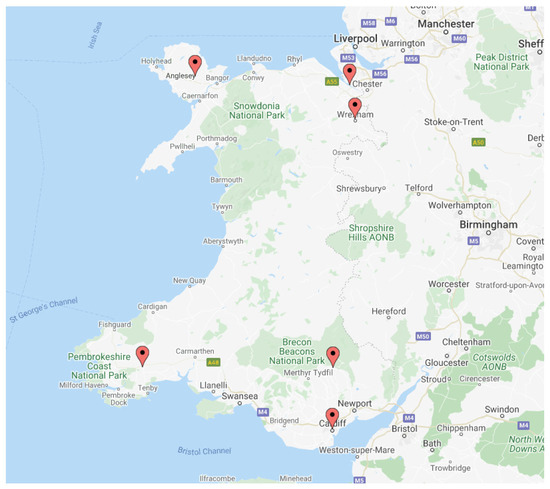
Figure 1.
Locations in Wales, clockwise from the top left. (Llangefni, Shotton, Wrexham, Brynmawr, Cardiff, and Narberth).
All six locations experience the highest daily average solar flux in the warm months as presented for Cardiff in Figure 2. Looking forward to 2030 and 2070, the daily solar flux is projected to increase in all locations, with the largest changes from baseline expected in the warmer months from May to September. The daily solar flux, averaged over the whole year, is also projected to increase in all locations, as shown in Figure 3 and Figure 4.
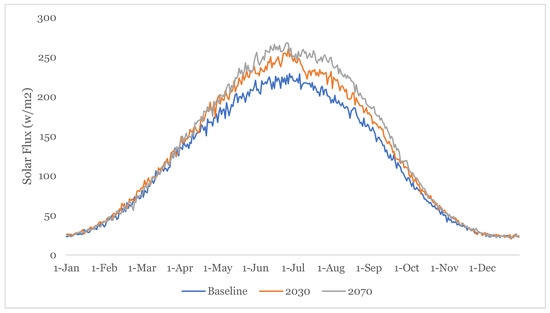
Figure 2.
Annual profile of daily average solar flux in Cardiff for baseline, 2030 and 2070.
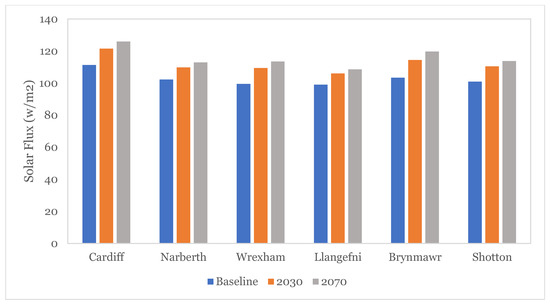
Figure 3.
Daily average solar flux averaged over the study period for six locations throughout Wales for baseline, 2030 and 2070.
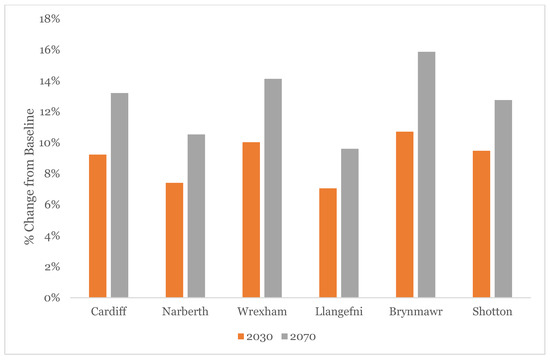
Figure 4.
Change in average daily solar flux for 2030 and 2070.
Brynmawr is projected to see the greatest increase in average daily solar flux, with an 11% increase from baseline by 2030 and a 16% increase by 2070. Meanwhile, Llangefni, the location with the least pronounced increase, is still projected to experience a 7% increase from baseline by 2030 and a 10% increase from baseline by 2070.
Across all six locations the daily average relative humidity is highest in the winter months and lowest in the summer months. This is demonstrated for Cardiff in Figure 5.
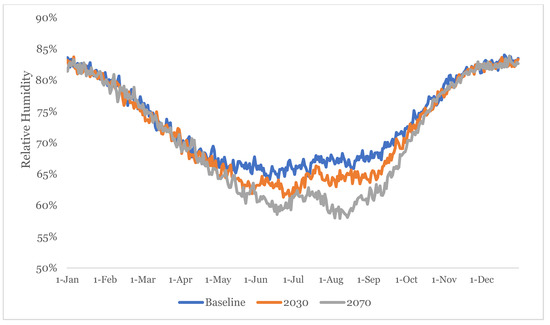
Figure 5.
Annual profile of daily average outdoor relative humidity in Cardiff for baseline, 2030 and 2070.
As can be seen for Cardiff, and which holds true for all locations, the largest relative humidity changes from baseline to 2030 and 2070 are seen in the warmer months from May to September. During this period the relative humidity is projected to decrease from baseline. Although the biggest change is in the summertime relative humidity, the daily relative humidity is also projected to decrease when averaged over the whole year, as shown in Figure 6 and Figure 7. The biggest decrease in average daily outdoor relative humidity is projected in the high elevation location of Brynmawr, with a 1.6% decrease by 2030 and a 3.7% decrease by 2070.
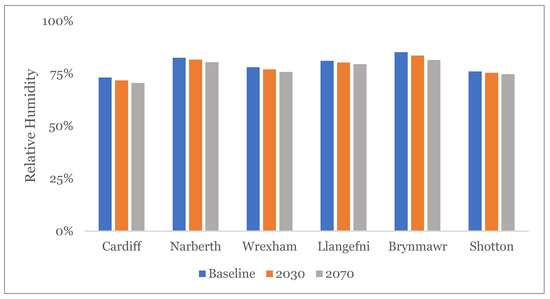
Figure 6.
Daily average outdoor relative humidity for baseline, 2030 and 2070.
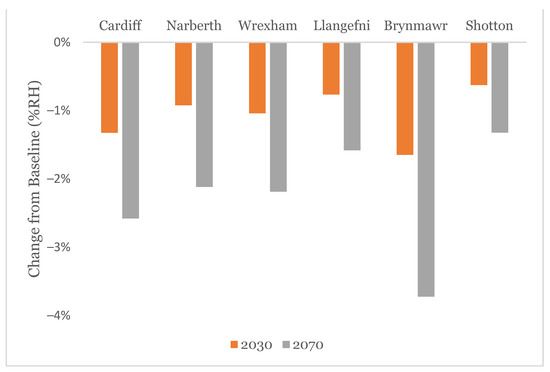
Figure 7.
Change in average daily outdoor relative humidity for 2030 and 2070.
Precipitation trends exhibit a more varied set of projections by location and time period. In general, the wettest times of year across all locations are the colder months, as seen in Figure 8 for Cardiff. Looking forward to 2030 and 2070, the colder months are projected to see an increase in precipitation, while the warmer months are projected to see a decrease in precipitation. However, on an annual scale, the trends are not as unanimous across locations as they are for the other climate variables. Cardiff, Narberth, Llangefni, and Brynmawr are projected to experience an increase in annual precipitation by 2030 and then another increase by 2070 (Figure 9). Conversely, in 2030, Wrexham is projected to see 0.7% more annual precipitation than baseline, but 1.7% less annual precipitation than baseline come 2070. Furthermore, Shotton’s annual precipitation is projected to stay close to baseline levels for both projections, with a 0.6% increase from baseline by 2030, followed by a drop to 0.2% above baseline by 2070 (Figure 10).

Figure 8.
Annual profile of average monthly precipitation in Cardiff for baseline, 2030 and 2070.
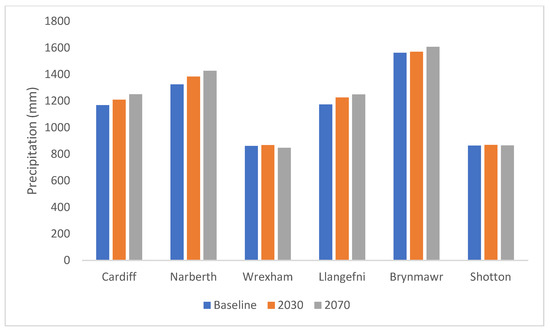
Figure 9.
Average annual precipitation for six locations throughout Wales for baseline, 2030 and 2070.
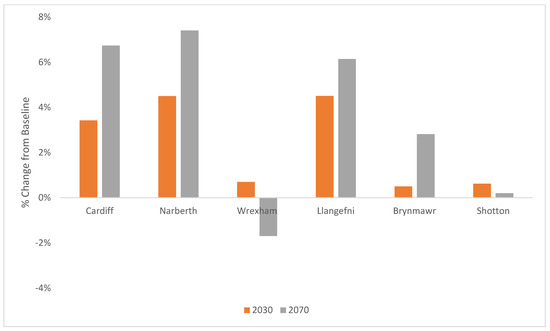
Figure 10.
Change in average annual precipitation for six locations throughout Wales for 2030 and 2070.
Overall, Narberth is projected to experience the greatest increase in annual precipitation, with a 4.5% increase from baseline by 2030 and a 7.4% increase from baseline by 2070. However, Wrexham is expected to see a 0.7% increase from baseline by 2030, followed by a decrease to 1.7% below baseline by 2070.
3.2. Building Fabric Deterioration
Table 2 presents the forecast level of deterioration and adjusted service lives for five building-fabric components in Cardiff. No data were available for sealants, therefore this has not been included in the analysis. The forecast level of deterioration for each climate variable is deemed “High” if the resulting adjusted service life for a given climate variable is projected to be lower than baseline, and “Low” if it is projected to be higher than baseline. The level of deterioration for each climate variable is rolled into a single forecast level of deterioration, as shown in Table 2, which is deemed “Mild” if only one of the three climate variables shows “High” deterioration, “Moderate” if two show “High”, and “Severe” if all three show “High”. The adjusted service life values are calculated using the solar flux, relative humidity and precipitation climate projections presented above. The percentage change from baseline costs represent the costs associated with the change in the number of replacements that are projected to be necessary in comparison to the baseline service life of the given building component. Blank spaces correspond to building components that were not found to be impacted by the corresponding climate variable. In Cardiff, solar flux and precipitation are projected to increase from baseline to 2030, and then again from 2030 to 2070. This leads to adjusted service lives for these two climate variables in 2030 and 2070 that are lower than the baseline, and replacement costs that are higher than baseline. Conversely, relative humidity in Cardiff is projected to decrease, which leads to increases in adjusted service life and a decrease in replacement costs.

Table 2.
Results for building-fabric degradation analysis for Cardiff showing deterioration classification, adjusted service life, and change in cost for 2030 and 2070.
Table 2 provides an indication of how that component may fare under the combined stresses of the climate variables. For example, by 2030, the roof tile service life is projected to decrease by 1.9 years as a result of increased solar flux degradation, an increase of 1.1 years as a result of decreased relative humidity, and a decrease of 0.3 years as a result of increased precipitation. These service life changes equate to a 6.7%, −3.6%, and 1.1% change in in replacement costs, respectively. The total across the adjusted service life values for the climate variables applicable to roof tiles gives an estimated decrease in adjusted service life of 1.1 years, indicating an overall trend towards a decreased service life when all climate variables are considered. It is important to note that degradation data are only available as it pertains to single climate variables, and not for the impact of multiple climate variables simultaneously. For this reason, totalling the change in service life and cost across each climate variable simply gives an indication of impact trends, while more work is needed to accurately assess the impact from the combination of climate variables.
3.3. Financial Implications
The financial implications of these adjusted service lives for individual building materials and components have been calculated and presented in Table 3. Meanwhile, cost implication results were generated on a per-dwelling basis as an average across the 6 locations and are presented in Table 4. Dwelling costs are generated for a typical Welsh dwelling, including a typical value for the exterior façade and roof area, number of windows, percentage of area needing replacement for each building component, amongst other characteristics. The costs presented represent a change from baseline. Per-dwelling costs represent those incurred over the lifespan of the respective building material. For this reason, costs between building materials cannot be compared since they are likely to be incurred over different timespans.

Table 3.
Adjusted service lives for change in replacement costs by dwellingover the life of the building material.

Table 4.
Change in replacement costs by dwelling over the life of the building material.
3.4. Climate Vulnerability Modelling Limitations
This study aimed to inform a deeper understanding of the vulnerability of the Welsh housing stock to a changing climate. Although the methodology described above achieves detailed results that can help inform repair and maintenance, there are limitations to the analysis. The grid for the UKCP18 wind data is offset from the other variables for the local (2.2 km) projections. As a result, it could not be used as an input for this analysis. However, the studies referenced in the ISO 15686 factor method include many impact areas which affect a building component’s service life, of which the most relevant to climate change are exposure to WDR and exposure to moisture. Although WDR was not an option, exposure to moisture, which is impacted by high relative humidity and increased precipitation, is; both were available in UKCP18 local (2.2 km) projections, i.e., with the correct grid.
A building’s exterior fabric is made up of many different materials, each uniquely impacted by a variety of climate variables. A group of six building-fabric components were chosen in this study as they represent the principal elements of Welsh dwelling construction. However, even for this limited selection of building-fabric components there is an absence of available data on definitive climatic thresholds and the associated impact on durability if that threshold is breached. The published durability factors were defined for qualitative thresholds, typically binary in nature, such as “moderate” or “severe” or, in the case of solar exposure, by compass orientation. As such, the lowest of the published durability factors (having the most impact on service life) was assigned for a given climate variable if it was projected to increase from the baseline and the highest durability factor was assigned if it was projected to decrease from the baseline. Additionally, data are absent on the combined effect of multiple climate variables on any of the building-fabric components. For example, a single adjusted service life could not be calculated for a component from the combination of high solar exposure, high precipitation exposure, and low relative humidity exposure. Instead, separate adjusted service lives were presented for each of the three climate variables for each building-fabric component. Additionally, while there are likely additional climate variables that impact the durability of these building components, only three were analysed because of data and project scope limitations. It is important to note that the other climate variables which may have detrimental impacts, including extreme events, principally manifest in Wales in the form of high winds, storms with concentrated downpours, and associated events, such as flooding.
If future work is able to establish service life factors that are tied to quantified climate thresholds, these could be integrated into the methodology outlined here. The result would be a better understanding of the impact that changes in each climate variable have on the service life of each building component. Additionally, it would be useful if future research focused on establishing service life factors for additional climate variables and for a combination of climate variables on a single building component.
Building fabric cost implications were calculated assuming a typical Welsh dwelling, as detailed above. Each building component was also assigned a per-unit replacement cost and a percentage of building material in a typical dwelling needing replacement at the end of its service life, as presented in Table 4. A more tailored replacement cost figure for a specific building or portfolio of buildings can be garnered in practice if the building’s characteristics are used in place of the representative values.
3.5. Applying Climate Vulnerability Modelling
Building fabric vulnerabilities have been established for solar flux, relative humidity, and precipitation, measured using an adjusted service life. This information aims to inform repair, maintenance, and refurbishment planning. The building-fabric vulnerability results can be applied, alongside with established knowledge and understanding of building-fabric performance, and associated deterioration mechanisms, to better inform frequency of repair and maintenance to mitigate further damage. For example, Table 5 provides a summary of known deterioration mechanisms and severe event safety measure requirements [41,42,44]. This knowledge can be used alongside known climate vulnerabilities and associated costs, repair, and maintenance routines [Table 2, Table 3 and Table 4], to plan building maintenance and repair, including any adaptations that might be required, in this instance materials and components reflect those for a pre-1919 terraced sandstone dwelling in Cardiff.

Table 5.
Known material and component deterioration mechanisms and severe event safety measures to inform repair, maintenance, and adaptation works.
3.6. Adaptation Strategies
If the Welsh government, building managers, and individual dwelling owners are to avoid the anticipated expense of climate change, government policy must give people agency to better manage extreme hazard risks but also cumulative degradation impacts, i.e., provide individuals, property managers, and the wider building and construction industry with legislation and tools, including appropriate skills and training, to better understand the hazards and risks, and to maintain and adapt domestic properties. Figure 11 provides a summary of building-fabric vulnerabilities as identified in the research and proposes climate-responsive behavioural changes for improved maintenance, and subsequent repair and adaptation resolutions based on both the literature [45] and the aforementioned workshops.
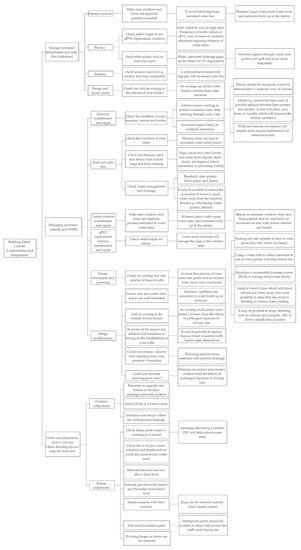
Figure 11.
Building fabric vulnerabilities and adaptations.
It is recognised that climate vulnerabilities, and therefore maintenance, repair, and adaptation priorities, will also be contingent on a dwelling’s location, orientation, age, and construction typology, and influenced by previous interventions including energy efficiency measures, such as external, internal, and cavity wall insulation. Additionally, it may be necessary to prioritise extreme event modifications, such as those associated with flood risks. Consequently, it is understood that not all the challenges outlined in Figure 11 will be pertinent to every dwelling. However, the results of this research highlight the importance of climate-responsive behaviours and the value of regular maintenance and repair as a first defence to climate change. For example, regular maintenance of building envelopes will both reduce material deterioration and improve building performance and could potentially mitigate the need for additional energy efficiency measures, for example. Climate-responsive behavioural adjustments, as well as and building-fabric modifications, may be required, but the regular maintenance and timely repair are low-cost decisions and start with attitudes and behaviours towards building upkeep; and can be considered as a time investment in prevention, rather than a more costly investment to remedy a problem.
4. Discussion and Conclusions
This research has explored known building-fabric deterioration mechanisms and climate hazards, risks, and stressors. The results of the study offer a set of quantifiable and measurable climate vulnerabilities associated with housing building-fabric. The objective being to address evidence gaps identified by the Welsh government, which included risks to building-fabric from moisture, wind, and driving rain under future changes in weather patterns. Climate change will undoubtedly influence how we manage the physical condition of our homes in the future, if it is not already. In general terms, Wales will experience warmer but wetter weather that will bring certain challenges for building upkeep, especially considering the high proportion of older properties, over a quarter of which are more than 100 years in age. Certainly, the need to repair, and in some cases rebuild, due to damage caused by changing precipitation patterns, including WDR, which may lead to more severe storm events and consequent flooding, will become more prevalent.
The climate vulnerability modelling asserts there will be a modest reduction in the service life of building materials due to increases in and changing patterns of precipitation and subsequent moisture ingress. Although modest, with 1.5 million dwellings in Wales, the impact is significant. To that end, climate change will alter existing building-fabric performance, as identified in the climate vulnerability modelling. For example, solid masonry walls, the standard way to build in the late 1800s and early 1900s, are characterised by higher surface water absorption coefficients and are more sensitive to exterior climate factors, such as rain, wind, and solar radiation. Changes in climate factors are expected to accelerate the deterioration of masonry and detailing and undermine binders and coating on buildings [8,9]. Wall orientation will also make a difference and some building façades will require more attention than others, as south-facing walls dry out quicker than north-facing walls, the higher solar flux reducing relative humidity significantly [46].
Previous interventions or retrofits may also impact on the performance of buildings as weather patterns change, for example adding insulation to a property has been found, in some cases, to result in interstitial condensation, surface condensation, mould growth, and even decay, the effects of which could be expediated by climate change [47]. Meanwhile, the risk of mould growth increases considerably when the relative humidity of a construction material exceeds 80%. Buildings susceptible to damp, both now and under future climate projections, will most certainly require additional attention. Hygrothermal impacts, including repeated wetting, drying, freezing, and thawing of building-fabric, can cause problems such as damp, condensation, and mould growth, resulting in loss of thermal performance, and may even lead to premature material failure. However, advocating climate-responsive behaviour through regular maintenance and repair, will not only reduce the risks associated with changing weather patterns, but also encourage energy efficiency, by improving the thermal performance of the building envelope. This will reduce the risk of adverse climate related outcomes, and increased vulnerability to climate change, now or in the future.
Investment in climate adaptation, alongside associated skills and training, is crucial. Certainly, a review of recent government policy and published academic literature shows that climate change mitigation and associated carbon reduction targets remain to be the primary climate change objective for the design and construction industry. However, known building-fabric performance and the result of the climate vulnerability modelling indicate that climate-responsive modifications, resulting in more regular maintenance, timely repair, and appropriate adaptation, have the ability to steady any decline in service life associated with climate change and has the potential to reduce projected costs associated with a decrease in building-fabric service life.
Author Contributions
Conceptualization, C.H. and P.C.; methodology, C.H., M.H., P.C. and J.H.; software, M.H., J.H.; validation, C.H., M.H., P.C. and J.H.; formal analysis, C.H., M.H., P.C. and J.H.; investigation, C.H., M.H., P.C. and J.H.; resources, C.H., M.H., P.C. and J.H.; data curation, C.H., M.H., P.C. and J.H.; writing—original draft preparation, C.H.; writing—review and editing, C.H., M.H. and P.C.; project administration, C.H.; funding acquisition, C.H. All authors have read and agreed to the published version of the manuscript.
Funding
This research was funded by the Welsh Government’s environmental evidence program.
Institutional Review Board Statement
Not applicable.
Informed Consent Statement
Not applicable.
Data Availability Statement
The data presented in this study are available on request from the corresponding author.
Conflicts of Interest
The authors declare no conflict of interest.
References
- Hao, L.; Herrera-Avellanosa, D.; Del Pero, C.; Troi, A. What are the implications of climate change for retrofitted historic buildings? A literature review. Sustainability 2020, 12, 7557. [Google Scholar] [CrossRef]
- Sanders, C.H.; Phillipson, M.C. UK adaptation strategy and technical measures: The impacts of climate change on buildings. Build. Res. Inf. 2003, 31, 210–221. [Google Scholar] [CrossRef]
- Committee on Climate Change. UK Housing: Fit for the Future? 2019. Available online: https://www.theccc.org.uk/publication/uk-housing-fit-for-the-future/ (accessed on 12 January 2022).
- Committee on Climate Change CCRA2. UK Climate Change Risk Assessment 2017. 2017. Available online: https://www.gov.uk/government/publications/uk-climate-change-risk-assessment-2017 (accessed on 12 January 2022).
- Natural Resources Wales. “State of the Natural Resources” (SoNaR) Report. 2020. Available online: https://naturalresources.wales/evidence-and-data/research-and-reports/state-of-natural-resources-report-sonarr-for-wales-2020/sonarr2020-downloads/?lang=en (accessed on 13 January 2022).
- Committee on Climate Change. CCRA3. UK Climate Change Risk Assessment 2021. 2021. Available online: https://www.ukclimaterisk.org (accessed on 13 January 2022).
- Met Office. Climate Change in the UK. 2020. Available online: https://www.metoffice.gov.uk/weather/climate-change/climate-change-in-the-uk#how-will-climate-change-affect-the-uk (accessed on 12 January 2022).
- Curtis, R.; Hunnisett Snow, J. Short Guide-Climate Change Adaptation for Traditional Buildings; Historic Environment Scotland: Edinburgh, UK, 2016. [Google Scholar]
- Cavalagli, N.; Kita, A.; Castaldo, V.L.; Pisello, A.L.; Ubertini, F. Hierarchical environmental risk mapping of material degradation in historic masonry buildings: An integrated approach considering climate change and structural damage. Constr. Build. Mater. 2019, 215, 998–1014. [Google Scholar] [CrossRef]
- Budaiwi, I.; Abdou, A. Impact of indoor air conditions and solar radiation on moisture accumulation within multi-layer non-cavity walls. J. Therm. Envel. Build. Sci. 1999, 23, 123–144. [Google Scholar] [CrossRef]
- Arumägi, E.; Pihlak, M.; Kalamees, T. Reliability of interior thermal insulation as a retrofit measure in historic wooden apartment buildings in cold climate. Proc. Energy Procedia 2015, 78, 871–876. [Google Scholar] [CrossRef] [Green Version]
- Franzoni, E.; Gentilini, C.; Graziani, G.; Bandini, S. Towards the assessment of the shear behaviour of masonry in on-site conditions: A study on dry and salt/water conditioned brick masonry triplets. Constr. Build. Mater. 2014, 65, 405–416. [Google Scholar] [CrossRef]
- Camuffo, D. Microclimate for Cultural Heritage: Measurement, Risk Assessment, Conservation, Restoration, and Maintenance of Indoor and Outdoor Monuments, 3rd ed.; Elsevier: Oxford, UK, 2019. [Google Scholar]
- Facconi, L.; Conforti, A.; Minelli, F.; GA Plizzari, G.A. Improving shear strength of unreinforced masonry walls by nano-reinforced fibrous mortar coating. Mater. Struct. 2014, 48, 2557–2574. [Google Scholar] [CrossRef]
- D’Ayala, D.; Aktas, Y.D. Moisture dynamics in the masonry fabric of historic buildings subjected to wind-driven rain and flooding. Build. Environ. 2016, 104, 208–220. [Google Scholar] [CrossRef] [Green Version]
- Brooks, J.J. Concrete and Masonry Movements; Butterworth-Heinemann: Oxford, UK, 2015. [Google Scholar]
- Hall, K.; Hall, A. Weathering by wetting and drying: Some experimental results. Earth Surf. Process. Landf. 1996, 21, 365–376. [Google Scholar] [CrossRef]
- Yavuz, A.B. Durability assessment of the Alaçatı tuff (Izmir) in western Turkey. Environ. Earth Sci. 2012, 67, 1909–1925. [Google Scholar] [CrossRef]
- Erkal, A.; D’Ayala, D.; Sequeira, L. Assessment of wind-driven rain impact, related surface erosion and surface strength reduction of historic building materials. Build. Environ. 2012, 57, 336–348. [Google Scholar] [CrossRef] [Green Version]
- Nik, V.M.; Mundt-Petersen, S.O.; Kalagasidis, A.S.; De Wilde, P. Future moisture loads for building facades in Sweden: Climate change and wind-driven rain. Build. Environ. 2015, 93, 362–375. [Google Scholar] [CrossRef]
- Hagentoft, C.E.; Kalagasidis, A.S. Mould growth control in cold attics through adaptive ventilation: Validation by field measurements. In Proceedings of the 11th International Conference on Thermal Performance of the Exterior Envelopes of Whole Buildings, Clearwater, FL, USA, 5–9 December 2010. [Google Scholar]
- Su, B. Prevention of winter mould growth in housing. Arch. Sci. Rev. 2006, 49, 385–390. [Google Scholar] [CrossRef]
- Viitanen, H.A.; Vinha, J.; Salminen, K.; Ojanen, T.; Peuhkuri, R.; Paajanen, L.; Lahdesmaki, K. Moisture and Bio-deterioration Risk of Building Materials and Structures. J. Build. Phys. 2010, 33, 201–224. [Google Scholar] [CrossRef]
- Grant, C.; Flannigan, C.H.B.; Bravery, A.F. The moisture requirements of moulds isolated from domestic dwellings. Int. Biodeterior. 1989, 25, 259–284. [Google Scholar] [CrossRef]
- World Bank. Economics of Adaptation to Climate Change—Synthesis Report; World Bank: Washington, DC, USA, 2010; Available online: http://documents.worldbank.org/curated/en/646291468171244256/Economics-of-adaptation-to-climate-change-Synthesis-report (accessed on 12 January 2022).
- Berdica, K. An Introduction to road vulnerability: What has been done, is done and should be done. Transp. Policy 2002, 9, 117–127. [Google Scholar] [CrossRef]
- Erath, A.; Birdsall, J.; Axhausen, K.; Hajdin, R. Vulnerability assessment methodology for Swiss Road network. Transp. Res. Rec. J. Transp. Res. Board 2009, 2137, 118–126. [Google Scholar] [CrossRef]
- Chinowsky, P.; Arndt, C. Climate Change and Roads: A Dynamic Stressor–Response Model. Rev. Dev. Econ. 2012, 16, 448–462. [Google Scholar] [CrossRef]
- Centre for Environmental Data Analysis. Met Office Hadley Centre (2019): UKCP Local Projections at 2.2km Resolution for 1980–2080. 2021. Available online: https://catalogue.ceda.ac.uk/uuid/d5822183143c4011a2bb304ee7c0baf7 (accessed on 12 January 2022).
- Met Office. UKCP18 Science Overview Report. 2019. Available online: https://www.metoffice.gov.uk/pub/data/weather/uk/ukcp18/science-reports/UKCP18-Overview-report.pdf (accessed on 12 January 2022).
- Fung, F.; Gawith, M. UKCP18 for UKCP09 Users, UKCP18 Guidance. Met Office Hadley Centre, Exeter. 2018. Available online: https://www.metoffice.gov.uk/binaries/content/assets/metofficegovuk/pdf/research/ukcp/ukcp18-guidance-ukcp18-for-ukcp09-users.pdf (accessed on 12 January 2022).
- Riahi, K.; Rao, S.; Krey, S.; Cho, C.; Chirkov, V.; Fischer, G.; Kindermann, G.; Nakicenovic, N.; Rafaj, P. RCP 8.5—A scenario of comparatively high greenhouse gas emissions. Clim. Change 2011, 109, 33–57. [Google Scholar] [CrossRef] [Green Version]
- Schwalm, C.R.; Glendona, S.; Duffya, P.B. RCP8.5 tracks cumulative CO2 emissions. Proc. Natl. Acad. Sci. USA 2020, 117, 19656–19657. [Google Scholar] [CrossRef]
- Silva, A.; de Brito, J.; Gasper, P.L. Application of the factor method to maintenance decision support for stone cladding. Autom. Constr. 2012, 22, 165–174. [Google Scholar] [CrossRef]
- Menzies, G.F. Service Life Planning Analysis of Accoya Timber Used in Windows. 2013. Available online: https://www.accoya.com/app/uploads/2020/05/Service-Life-Report-for-Window-Frame.pdf (accessed on 12 January 2022).
- Galbusera, M.M.; de Brito, J.; Silva, J.A. Application of the Factor Method to the Prediction of the Service Life of Ceramic External Wall Cladding. J. Perform. Constr. Facil. 2015, 29, 04014086. [Google Scholar] [CrossRef]
- Jardim, A.; Silva, A.; de Brito, J. Application of the factor method to the service life prediction of architectural concrete. Can. J. Civ. Eng. 2019, 46, 1054–1062. [Google Scholar] [CrossRef] [Green Version]
- Serralheiro, M.I.; de Brito, J.; Silva, A. Methodology for service life prediction of architectural concrete facades. Constr. Build. Mater. 2017, 133, 261–274. [Google Scholar] [CrossRef]
- Silva, A.; de Brito, J.; Gasper, P.L. Methodologies for Service Life Prediction of Buildings with a Focus on Facade Claddings; Springer International Publishing: Cham, Switzerland, 2016. [Google Scholar]
- Berdahl, P.; Akbari, H.; Levinson, R.; Miller, W.A. Weathering of roofing materials—An overview. Constr. Build. Mater. 2008, 22, 423–433. [Google Scholar] [CrossRef] [Green Version]
- BS ISO 15686-1:2011; Buildings and Constructed Assets—Service Life Planning, Part 1: General Principles and Framework. The British Standards Institute: London, UK, 2011.
- BS ISO 15686-8:2008; Buildings and Constructed Assets—Service-Life Planning—Part 8: Reference Service Life and Service-Life Estimation. The British Standards Institute: London, UK, 2008.
- BS 7543: 2015; Guide to Durability of Buildings and Building Elements, Products and Components. The British Standards Institute: London, UK, 2015.
- Basu, S.; Orr, S.A.; Aktas, Y.D. A Geological Perspective on Climate Change and Building Stone Deterioration in London: Implications for Urban Stone-Built Heritage Research and Management. Atmosphere 2020, 11, 788. [Google Scholar] [CrossRef]
- Vardoulakis, S.; Dimitroulopoulou, C.; Thornes, J.; Lai, K.-M.; Taylor, J.; Myers, I.; Heaviside, C.; Mavrogianni, A.; Shrubsole, C.; Chalabi, Z.; et al. Impact of climate change on the domestic indoor environment and associated health risks in the UK. Environ. Int. 2015, 85, 299–313. [Google Scholar] [CrossRef] [Green Version]
- Marincioni, V.; Altamirano, H. Effect of orientation on the hygrothermal behaviour of a capillary active internal wall insulation system. In Proceedings of the 10th Nordic Symposium of Building Physics, Lund, Sweden, 15–19 June 2014. [Google Scholar]
- Havinga, L.; Schellen, H. The impact of convective vapour transport on the hygrothermal risk of the internal insulation of post-war lightweight prefab housing. Energy Build. 2019, 204, 109418. [Google Scholar] [CrossRef]
Publisher’s Note: MDPI stays neutral with regard to jurisdictional claims in published maps and institutional affiliations. |
© 2022 by the authors. Licensee MDPI, Basel, Switzerland. This article is an open access article distributed under the terms and conditions of the Creative Commons Attribution (CC BY) license (https://creativecommons.org/licenses/by/4.0/).